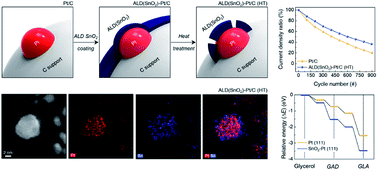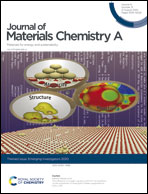Atomic-layer-deposited SnO2 on Pt/C prevents sintering of Pt nanoparticles and affects the reaction chemistry for the electrocatalytic glycerol oxidation reaction†
Abstract
Atomic layer deposition (ALD) is an efficient technique that allows atomic-level surface control of metal catalysts for the design and development of electrocatalytic materials. Herein, we report a strategy for efficient catalyst design using a particle ALD method to enhance the electrocatalytic glycerol-oxidation-reaction (GOR) performance. Atomically controlled thin SnO2 layers were deposited on a carbon-supported Pt nanoparticle (Pt/C) surface using the ALD technique. The resulting SnO2 overcoated Pt/C (ALD(SnO2)–Pt/C) was then heat-treated at 400 °C under a N2 atmosphere. The onset potential as a kinetic parameter decreased with ALD (SnO2) coatings. The turnover frequency (TOF) for the GOR showed similar values for the tested samples (TOF of Pt/C: 74.86 h−1 and TOF of ALD(SnO2)–Pt/C: 91.29 h−1). Interestingly, interactions between the ALD SnO2 overcoating and Pt nanoparticles improved the catalytic stability for the GOR, preventing sintering of Pt nanoparticle catalysts. This demonstrates that an ALD SnO2 coating on defect sites of Pt can diminish Pt sintering for the GOR. From the GOR in an electrochemical batch reactor, the ALD(SnO2)–Pt/C catalyst also generated more glyceraldehyde (GAD) product than uncoated Pt/C at a similar glycerol conversion level. The density functional theory (DFT) calculations suggest that the binding energies of glycerol and reaction intermediates change at the interface of the SnO2-coated Pt surface compared to those at the Pt surface only, thus affecting the reaction chemistry for the electrocatalytic GOR. This work highlights how we can control reaction performance measures such as catalytic stability and product selectivity by using the particle ALD technique for electrocatalytic reactions such as glycerol oxidation.

- This article is part of the themed collection: Journal of Materials Chemistry A Emerging Investigators


 Please wait while we load your content...
Please wait while we load your content...